September 20th, 2010 · No Comments
That’s what every city in the world should be, because they don’t have as much green as London does. No, I don’t mean money, I mean real green, in the form of parks.
As I write this, I am sitting in my favorite of London’s parks, Regent’s Park. In fact, I didn’t realize that it was my favorite until I ventured here, knowing that I needed to write about parks and wanting to get away from the city for a while without going far from the Arran House. After consulting my A to Z, I found that we’ve been living for a month not 15 minutes away from one of London’s most beautiful parks, which is saying something, because London has some wonderful ones. Of these, I have visited three, and they are probably London’s most famous: Regent’s, Hyde, and St. James.
I’ll start with Regent’s. As I said, I came here needing to be somewhere quiet, and most importantly, green. I love the outdoors, and was feeling like I hadn’t gotten enough of them while in London. Regent’s quickly fixed that though. Probably best known for its prominent role in the 101 Dalmatians and James Bond (MI6 is near the Park), Regent’s Park is situated on 410 acres in Marylebone. Its perfectly trimmed flowerbeds, beautiful fountains, and huge open spaces are a breath of fresh air, literally and figuratively. The one thing that really differentiates Regent’s from the other parks I will talk about is the lack of tourists. Regent’s doesn’t have anything particularly special for tourists, as opposed to Hyde and St. James, so it is both less busy and quieter. It also houses the London Zoo (yes, the one that Harry Potter went to in the first book), for any animal lovers out there.

Regent's Park
Next up is Hyde, or specifically Kensington Gardens, which is contiguous with Hyde, and is often thought of as part of the same park (technically its not… I also visited Hyde, and it’s much the same as the Gardens). Like Regent’s, it features wide open spaces, fountains, and gardens. However, it also contains Kensington Palace (which also serves as a shrine to Princess Diana), the world-famous Peter Pan statue, and the Prince Albert Memorial, which all attract a lot of tourists, which increases the “busyness” of the park, and changes its atmosphere. It is still a very nice park, but it just doesn’t have the feel of Regent’s.

Peter Pan Statue in Kensington Gardens
Lastly, St. James Park. Once again, lots of open space, water features, and flowers. The big tourist attractions here completely surround the park, rather than being contained in it. These include, but are not limited to, the Houses of Parliament, Westminster Abbey, and Buckingham Palace. This brings a lot of people to the park which, while not a bad thing, makes it feel crowded, which is not how parks should be in my mind. It is an absolutely beautiful park though, despite its well-publisized history of, well, err… you know. For those that don’t, Edward II had dozens of children, none with his wife, and loved spending time in the park. I’ll let you do the math.
To wrap up, I’d like to mention that London’s parks have really cool birds. At Kensington and St. James, there are tons of brown geese and small little birds, pictures of which I’ve attached below. At Regent’s though, they seem to have completely different breeds of birds, which you can also see below. St. James also has pelicans, which I unfortunately don’t have pictures of.
I have no idea why the birds would be so different between one park and another, unless these birds were purposefully introduced to their respective parks, which would be a conclusion requiring an understanding of London parks history that I lack. Anyone with more insight, please feel free to chime in.

Bird characteristic of the populations found at Regent's Park

Swan, characteristic of the bird populations at Kensington Gardens and St. James Park
Tags: 2010 MatthewM
September 20th, 2010 · 1 Comment
Probably because I get a little claustrophobic in cities, my visits to parks have definitely been some of the highlights of my time in London. I enjoyed the sense of space, the people watching, and the sheer beauty of much of the landscaping. However, I did pick up on a certain artificiality throughout London’s Green space.
First of all, the lakes, which are in most cases absolutely beautiful, provide variety in scenery, are home to so many (sometimes exotic looking) species of birds, and they also provide a fun and novel activity for those who choose to rent paddle boats. In St. James Park, the bridge in the middle of the long, central pond is carefully positioned so that visitors can view Buckingham Palace in one direction and the London Eye in the other. The sheer overcrowding of the birds (and their excrement), especially in St. James Park makes me slightly uncomfortable. It seems as though London attempts to make up for the obvious lack of wildlife in the rest of its urban environment by crowding high quantities into small, carefully designated areas. In the “wetlands” area in Regent’s Park, I noticed a rat basking by the water’s edge along side the usual variety of birds. It goes to show I think, that it is impossible to completely keep out the less picturesque aspects of the city.
The gardens that I visited, and especially those in Regents Park were absolutely beautiful. Signs pointed out over twenty different species of roses, and everyone who I saw seemed to walk through slowly. However, when I reflected on how often the grass must be cut, to keep it that short and the precise patterns in which the plants were arranged, the set up seemed more like a human achievement than natural beauty. Hours of work daily clearly go in to maintaining the gardens.
Playgrounds in London’s parks also seemed equally controlled . Every playground that I have seen so far is fenced in, and most do not allow people in unless they have children with them. These playgrounds, which are often large and colorful, must be a welcome refuge to parents who live in the city and are accustomed to having to constantly watch their children in all public places. They definitely reinforce my impression that London makes it a priority to provide leisure space, but only carefully controlled leisure space.
That said, anyone is free to walk into the vast majority of London’s parks. People from all walks of life go there, though it is not a place to interact with strangers. It is socially acceptable to be alone, with large groups of friends or family, or anything in between. In many there is enough space to talk loudly, but I was able to find somewhere quiet in Regents Park to sit and read a book. Maybe all of the control allows for a greater sense of freedom.
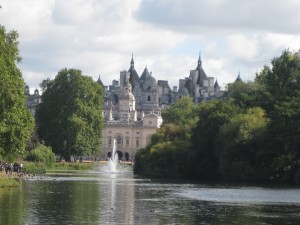
St. James Park (Personal Photo)

Hyde Park (personal photo)
Tags: 2010 Emily · Uncategorized
September 20th, 2010 · 2 Comments
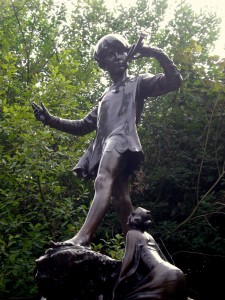
The thing that strikes me most about the parks here in London, aside from the astonishing size and quantity of them, is how kid focused they are. A couple of the girls and I paid a visit to Kensington Gardens last week and discovered this first hand. Before we even entered the park, we could hear the squeals of kids playing on the Diana Memorial Playground. Its design is actually based on the story of Peter Pan. Children can climb aboard Captain Hook’s pirate ship or play in Tiger Lily’s teepee. We wanted to go inside and get some pictures, but the sign on the gate states that if you do not have a child with you, you are not permitted in. I hadn’t ever encountered a child only park, and was honestly a little bit jealous that I couldn’t climb onto the pirate ship.
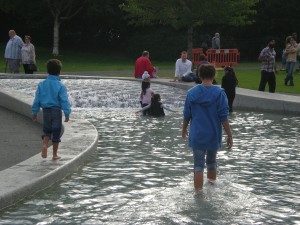
As a New Yorker, I’m partial to Central Park, but even I have to admit that the Brits seem to be beating us in this department. Although Central Park has many things to offer children, it doesn’t have anything that is kids only. I think its really admirable that London’s parks are so devoted to providing kids with a fun and safe environment. The State’s should seriously think about adopting this attitude.

Other locations in the park that seemed geared towards children were the Peter Pan statue, the Round Pond and (spreading into Hyde Park) the Diana, Princess of Wales Memorial Fountain. Although these places were not created specifically for children, it seemed like it was mostly families that were visiting.
Tags: 2010 Sarah
September 20th, 2010 · 5 Comments
I first noticed it one of our first walking tours. We were walking around Bloomsbury when we approached Bedford Square. It was a welcome patch of green and seemed reassuring and welcoming even from our first day in London, but on this day we actually tried to enter the small park. “Well it looks as if the Duke has decided to close the park today,” said Professor Qualls, his voice harboring a tone of disappointment. It was this moment that an idea dawned on me, public spaces in London aren’t truly “public,” they are mercifully given to the people by the aristocracy to brighten up their gloomy lives. For this reason, if the Duke of Bedford would like to have a personal picnic, or the Queen wants a day by the pond, they can close down any park they’d like for their own personal enjoyment.
This fact makes me a little perturbed. What is public space? That is one of the appealing things of Central Park in NYC, it is run by the publicly elected parks department officials. In that way the people decide who runs their parks. This is not the case in London.
The ownership of the “public” space is just another example of the feudal concepts of land ownership that still exist in England today. Just like the museums however, it seems to be the price one pays for perfectly manicured sports fields and classical European gardens that are open to the public. I am of course, talking about one of my favorite parks, Regent’s Park which I was able to return to a few times in pursuit of different things.
When it comes to parks in London however, the crown jewel (pun intended) is of course Hyde Park. It would take days of exploring to uncover all of the hidden landmarks and monuments.
So despite what you might think about the illusion of public space in a Monarchical space, these parks a a great place for a stroll on a sunny British day.
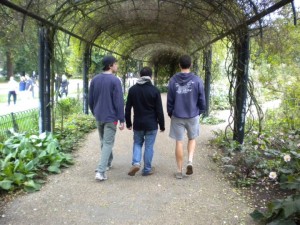
(personal photo)
Tags: 2010 MatthewG
September 20th, 2010 · 1 Comment
London is always described as a global city, a city of history, a city of movement. I have never heard it being described as a city of green space. So I was completely thrown off when I saw the number and magnitude of parks in the city. Literally in every community there is a park whether it’s a well off neighborhood or a less developed neighborhood; it has a park.
In Los Angeles, specifically in the area I live in there are hardly any parks or any parks that you really want to go to. Thus, it was a complete shock seeing such a populated city with so many parks that range in a variety of sizes and functions. The biggest that I have seen by far is Hyde Park. Hyde Park is right next to Buckingham Palace, making its size very logical. Its scenery ranges from fountains surrounded by beautifully well kept flower beds to fields and fields of grass and trees. This park is obviously surrounded by a lot of money to keep up its appearance as well as it is kept.

Around the area we are currently dwelling in, Russell Square is on a significantly smaller scale than Hyde Park but it is likewise surrounded by a well off community. The park is always well kept and sometimes sealed off to the public making access only available to those who live in the square. The park is used by children, yoga instructors, and readers in general. Overall there is a stark difference between life within this park and the surrounding fast pace community. It almost seemed that they have brought the suburb to the city.
Not all parks look as amazing as Hyde Park or Russell Square. In the East End, a community that is largely composed of immigrants from Bangladesh also have a community park, called Altab Ali Park. This park was the first I had seen at the time in London that was commemorating someone rather than being named after its location. Altab Ali was a young 25 year old Bangladeshi clothing worker who was murdered by three white teenage boys on his way home. Just learning about the nature of the name of the park gives you a different feeling about the surrounding community. The community in the East End is tightly knit but it is not necessarily based on their income but rather a form of protection to their neighbors. This park unlike the others is visibly un-kept and run down, a complete difference to those I have mentioned before. So even within British society I see that with money comes political power, sad but true.

Tags: 2010 Jamie
September 20th, 2010 · No Comments
London’s public parks are impressive, in their size, beauty, and sheer number. Most people go to these parks to play sports, have picnics, hang out with their mates (both kinds), sit and read under a tree, etc., but my favorite park activity is people watching; and nowhere in London is the people watching better than in Hyde Park’s Speaker’s Corner. Speaker’s Corner is like an internet chat forum come to life, attracting people from every imaginable social background and point of view. Immaculately dressed women toting around their four figure handbags walk by elderly Sikh men in skull caps with long, gray beards. Middle school aged children in football jerseys weave between bikers and joggers. Indian grandmas in wheelchairs are pushed by their grandkids past punk teenagers in six inch platform boots. London’s parks truly attract all kinds, and Speaker’s Corner is the ideal place to find a varied audience if you have something to say, simply set up your little stool, hop on, and begin your diatribe against the government, the media, the cursed masses, who or whatever. If you have anything even remotely interesting to say, a crowd will soon form around you. Wearing a funny costume doesn’t hurt either, the crazier the better.

Just a guy feeding the pigeons. (personal photo)
I’ve simply strolled through most of the parks here, stopping every now and then to admire a flower or dodge a pile of dog poop, but Hyde Park caught my attention and kept it. Right across from the tail end of the Oxford St. madness you will find the Marble Arch, and beyond it a massive expanse of green space. Speaker’s Corner is lodged conveniently in the middle. The first character I encountered was a militant African man speaking out against the war in Iraq. He looked to be about 25 or so, and around him stood a rather sizable crowd. There was also a group of four physically fit 20 somethings advertising a personal training service and attracting quite a crowd with their boxing gimmick. One of the men held up a pad on each hand and challenged people in the crowd to get in 200 punches in one minute. A group of south asian men egged each other on in friendly competition as the crowd laughed and cheered. I was asked to participate, but declined the request. After I had had my fill of watching overweight middle-aged men try and fail to show off athletic prowess, I moved over to listen to a capital C Crazy preacher and the bemused, laughing, and heckling crowd around him.

Belligerent preacher pointing at me and asking me something silly like if I knew where I was going when I died. (personal photo)
My favorite speaker was a grizzled old man sartorially channeling the Gorton’s Fisherman. He had a much smaller crowd around him, an interesting mix of homeless people and business men in suits and ties, and me. He wasn’t so much Speaking as having an intimate conversation with his little crowd, discussing poetry and painting, interspersed with personal anecdotes of questionable validity.
Past all of this, Hyde Park is like all the rest, and if you walk in far enough you will undoubtedly be able to stake out your own patch of serenity. Muslin women in full burkas sit and read, couples sit shoulder to shoulder on blankets, its all really a very nice scene. I guess the behavior in the park could be described as English, in that, aside from the liminal space of Speaker’s Corner, people seem to keep themselves, on the whole, its all very orderly.
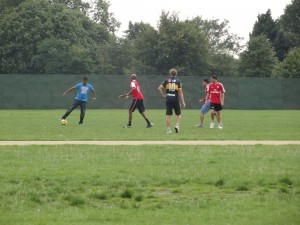
Mates playing a bit of footie. (personal photo)
Tags: 2010 Rachel · Uncategorized
September 20th, 2010 · 2 Comments

One of the things that make London distinct from almost any other city I have visited is the amount or room dedicated to parks. Walk a few blocks and you are bound to encounter a vast expanse of greenery, or see a small garden area with some benches and statues. While a few of these parks (particularly Greenwich) are more organic in nature, and feel just like large open space areas to roam, most of these parks feel planned out to the last blade of grass. Hyde Park boasts a picturesque lake(The Serpentine) with neatly laid out park benches around it. The grass in St. James’ Park is always perfectly cut, and the main bridge in the middle of the park looks like it was installed yesterday. The shrubbery and gardens in Regent’s Park remind one of Versailles. All of these places seem sculpted to be as visually pleasing as possible.

The trend seems to be that the more central the park to the center of the city (Particularly St. James’ and Regent’s Parks), the more likely the park is to be perfectly planned and sculpted. There are several possible reasons for this. One, it could simply be that the city anticipates more people going through these areas, so they want them to look the nicest. Another possibility is that they expect these areas to get the most tourists, and the parks exist more for image than actual recreation (a point I’ll get to a little later). Finally, it could be that these areas are closest to the monarchy, and they have more of a say over these parks. Whatever the reason, there is no doubt that the parks in London are far more mapped out and planned than a majority of parks in American cities.
The question now is: is such planning a good thing? I personally see it as more of a mixed bag. The parks here are much more visually stunning than most I have seen elsewhere. The feel of the parks harkens back to the original intention of the parks: to make the poor and unprivileged feel like they had access to the wealth of the monarchy. You really feel like you are walking through the Queen’s personal gardens when you take a stroll through Regent’s Park. However, this meticulous planning takes away a little bit of personality from the parks. I get no sense of true, organic, nature while walking through St. James because everything feels so mapped out. In addition, the regal nature of the parks appears to hinder a lot of activity within the parks. Most people seem to simply be walking slowly through these areas, or sitting on a park bench. There are rarely any cyclists, joggers, Frisbee players, kids running around, or anyone playing games. This inactivity is partially because a lot of games are banned in certain areas of the parks, but I think it is also due to the intimidating nature of such perfectly sculpted areas. After walking through the immaculately-trimmed hedges of Regent’s, or after crossing the bridge in St. James’ with the marvelous view of Buckingham Palace, it is hard to think: “Gee, this is the perfect place to run around and throw a Frisbee.” As a result of such overplanning, the parks lose this energy, and also a little bit of quirk.

I love the fact that London has so much green space, and that the city takes such good care of these areas. However, the parks are so meticulously sculpted that the areas seem almost unnatural. The lack of physical activity makes the area feel calm, but it also takes something away from its overall personality. I have enjoyed my time walking through London’s parks, but one wonders whether a bit less planning would make these areas more fun and inviting to the public.
Tags: 2010 Andrew
September 19th, 2010 · No Comments
Hailing from a small New England town tucked away in the white mountains of New Hampshire, I’m quite familiar with “green space.” I am actually more unaccustomed to living anywhere even close to a big city. Nearest to home is Boston—a two hour and fifteen minute haul. Therefore, one significant change in living in London is the disappearance of the monstrous mountains, endless trees, and, of course, fresh, crisp air. However, this wondrous city never ceases to surprise me. The parks I have visited are, as many can agree, blessed sanctuaries. I unintentionally have separated the innumerable parks into two groups: the larger, well known ones and the smaller, more secluded ones. Each sort of park provides a different environment.
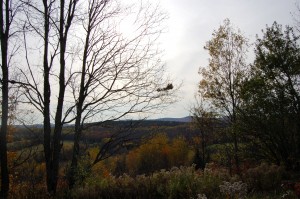
New England’s expansive green space (personal photo)
Of the “royal” parks (they’re labeled as such on London’s website) I have enjoyed Hyde Park and its nearby neighbor, Kensington Gardens; the Green Park, St. James’s Park, and the Reagent’s Park. It is at times entertaining to get lost in these massive parks. As a person wanders, he or she delves deeper into the green refuge and furthers him or herself from the city’s bustle and grime. I enjoyed exploring the incalculable monuments, memorials, and museums that materialize in these sprawling parks. These sanctuaries are not just for people to escape the city chaos; they serve as a safe place to preserve the surrounding area’s detailed history. I researched Hyde Park extensively and the pride the Londoners hold for the history of the park and the area itself is immediately evident. Speaker’s Corner, Rotten Row, Serpentine, the Wellington Museum—they all are housed within Hyde Park to be preserved and honored. For one, Hyde Park Corner Tube Station boasts tunnels decorated with elaborate murals illustrating the area’s history. How that for an introduction?

Hyde Park
The smaller parks have their own benefits. Scattered throughout the city and hidden in unexpected areas of London, these parks also present its community with an opportunity to take a break from the stresses of life. Although, they seem to enact stricter regulations, the parks offer a one with a place for relaxation, tranquility, entertainment, and community. Not to say these features do not apply to the larger parks, but these small parks seem much more intimate and more closely connected to the residents of the area. Also, these parks oftentimes possess a number of historical monuments but to a lesser degree in comparison to the royal parks. Even so, all of these parks in London, regardless of their size, give people a place to take a break from city life or just life in general. And to me, I particularly like that each one prides itself on its distinctive, detailed history.

Bedford Square, the park just down Gower Street
Tags: 2010 Mary
September 19th, 2010 · No Comments
The fact that London is 25% green absolutely boggles my mind. I love that the English place such an emphasis on green open areas, even in the middle of their capital. One of my favorite days during our trip here incorporated an afternoon in Regent’s Park. After my walking tour I went to the park, armed with a book and a sunny day. I then sat there for an hour and read. And while I did not get much actual reading done, I experienced something far more important – the breakdown of English cultural barriers. It started when someone’s puppy wandered over to me. Instead of calling back their dog, the owner just smiled at me and kept going, trusting that I would respect their pet and that it would go back to its owner when it so desired. This complete warmth towards a total stranger is not something I had experienced yet in the usually reserved London public sphere.
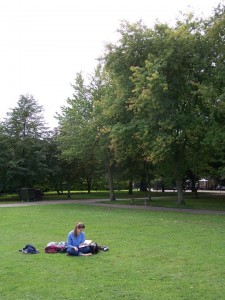
This breakdown of reserve was apparent the more I walked around the park. Everywhere I looked there were older gents playing with their dogs, mothers entertaining their children, and couples walking around paying more attention to each other than to their beautiful surroundings. While Kate Fox always talks about the English “social dis-ease” the atmosphere of Regent’s park was completely the opposite. Both at Regent’s Park and at St. James’ Park the wealth of examples of the English comfort, not with just themselves, but with those around them, showed more warmth than I am accustomed to in Los Angeles. It is almost as if the British use their parks as a place to escape the normally tight social boundaries regarding affection and interaction with strangers.
Parks also serve to remind the English that they’re inherently country folk. In times of crisis throughout English history (like the Plague), those who could afford to would flock to the countryside and to their agrarian roots. The English find safety in green open spaces and in city filled with smog and where everyone is in a constant rush, there has to be an emphasis these parks. These parks help make London English and help to remind English Londoners that they are English.
Tags: 2010 Amy
September 19th, 2010 · No Comments
The parks in London, as people have already noted, are places of beauty and enjoyment. Yet, they are not all created equal, well, no, used equally. When relaxing in various ones, I noticed that some were more touristy. In fact, within some, one area was more likely to be touristy that an other.
My first introduction to a London park was when we had class in Russell Square. Clearly, people weren’t used to seeing a group of students (much less Americans) in August discussing various ideas about immigration. Yet, I can’t imagine being at UCL and not using the space for at least small study groups, if not classroom discussions when the weather turns nice.
I adore the idea of small squares littered throughout the city ready for use whenever someone wants an escape from the business and chaos of the city. Of those I noticed, the squares I most wanted to go into were locked and only accessible by the area’s residents. I have mixed feelings on this. On one hand, it’s great for residents to have a safe place to go with their young children or a quiet place where they don’t have to worry about tourists wandering through talking loudly (oops). On the other, why shouldn’t these spaces be opened up for everyone? It feels like one more thing that add to English hypocrisy: they want to pretend when it’s convenient that class doesn’t count, but it seems to exist in these situations when the restricted squares seem to be in areas where income looks to be higher.
For the actual parks, my favorite has been Kensington Gardens. I loved the duality of the park: one side was quiet and peaceful and the other was busy, well, as busy as a park can be. Residents played with their dogs as tourists wandered through taking photos and trying to find the actual park, Hyde Park. Hyde Park was also rather enjoyable, but was far busier on the day I visited. Granted, searching for the Peter Pan statue also lends the visit to being centered around the busier areas. I enjoyed walking through Kensington and observing people and how they interacted with the space (mostly walking their dogs or playing fetch with them, as well as a few taking their young children out for a walk). In Hyde I felt like I was only there to check it off of my list of “Things To Do in London.”
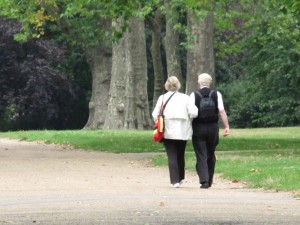
Regent’s Park, while a lot like Hyde in some regard also demonstrated this dualistic atmosphere. The park seemed to have a few tourists wandering through (especially as you got closer to the Zoo and in the more French style areas), but it also had a lot of Londoners, some out walking and others with their family (or dogs). I much preferred the areas that were mostly charming (and alarmingly uneven) paths, where others were walking with their dogs. The other thing that I liked about Regent’s was how family friendly it was. There was a playground that was obviously popular among families with young children.
I’ve enjoyed the parks that I’ve visited and they’ve helped convince me that London is actually my favorite city in the world because of their place in the life of the average Londoner (or student visiting for the month): they’re key to staying sane here. I thrive on the chaos of the city, but sometimes nothing is better than a quiet stroll through a park or an hour reading in a square. I hope that as I venture to other places in England that I will be able to go to a few other cities’ gardens/squares/parks and see how they differ.
Tags: 2010 Stephenie
























